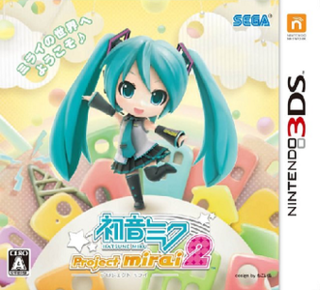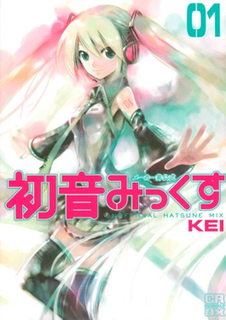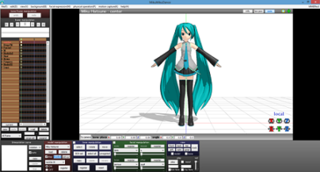 W
WCherry Blossom Memories is a 2015 Japanese youth drama music film directed by Atsushi Ueda, written by Hirotoshi Kobayashi and starring Maika Yamamoto and Kōdai Asaka. It is based on Sakura no Ame, a 2012 novel based on the Hatsune Miku song of the same title by halyosy. It had its world premiere at the Panorama section of the 28th Tokyo International Film Festival on October 29, 2015. It was released in Japan on March 5, 2016.
 W
W"Co Gal" is a song by Japanese musician hide, released sixteen years after his death. Originally demoed in 1998, the track was finished utilizing Vocaloid technology to mimic the artist's voice.
 W
WHatsune Miku and Future Stars: Project Mirai is a 2012 rhythm game created by Sega and Crypton Future Media for the Nintendo 3DS. The game is a spin-off of the Hatsune Miku: Project DIVA series of Vocaloid rhythm games and was first released on March 8, 2012 in Japan with no international release. Like the original the game primarily makes use of Vocaloids, a series of singing synthesizer software, and the songs created using these vocaloids most notably the virtual-diva Vocaloid Hatsune Miku. It is also the first Project Diva/Mirai game to include a Vocaloid made by Internet Co., Ltd. and the mascot Gumi appeared as a guest star.
 W
WHatsune Miku: Project DIVA is a series of rhythm games created by Sega and Crypton Future Media. The games have appeared on the PlayStation Portable, PlayStation 3, PlayStation 4, Nintendo 3DS, Sega RingEdge, PlayStation Vita, Nintendo Switch and mobile platforms. The series currently consists of 6 main titles and 3 spin-offs. The series primarily makes use of Vocaloids, a series of singing synthesizer software developed by the Yamaha Corporation, and the songs created using these Vocaloids, most notably the virtual-diva Vocaloid Hatsune Miku. It is the first video game series to utilize the Vocaloid software.
 W
WHatsune Miku: Project DIVA is a 2009 rhythm game created by Sega and Crypton Future Media for the PlayStation Portable. The game was first released on July 2, 2009 in Japan with no international release. The game primarily makes use of Vocaloid, a series of singing synthesizer software, and the songs created using these Vocaloids, most notably Hatsune Miku. The game is the first video game to utilize the Vocaloid software developed by the Yamaha Corporation.
 W
WHatsune Miku: Project DIVA 2nd is a 2010 rhythm game created by Sega and Crypton Future Media for the PlayStation Portable. The game is a sequel to the 2009 video game, Hatsune Miku: Project DIVA, and was first released on July 29, 2010 in Japan with no international release. Like the original the game primarily makes use of Vocaloids, a series of singing synthesizer software, and the songs created using these vocaloids most notably the virtual-diva Vocaloid Hatsune Miku. In addition, similar to the first Dreamy Theater, a companion game Hatsune Miku: Project DIVA Dreamy Theater 2nd that allows players to play the game on the PlayStation 3 with improved visuals.
 W
WHatsune Miku: Project DIVA Arcade is a 2010 arcade rhythm game created by Sega and Crypton Future Media for arcade machines. The game is a port of the 2009 video game, Hatsune Miku: Project DIVA, with updated visuals and was released on June 23, 2010 in Japan with limited international release in countries such as Singapore. Like the original the game primarily makes use of Vocaloids, a series of singing synthesizer software, and the songs created using these Vocaloids, most notably, the virtual diva Hatsune Miku.
 W
WHatsune Miku: Project DIVA Extend is a 2011 rhythm game created by Sega and Crypton Future Media for the PlayStation Portable. The game is an expansion to the 2010 video game, Hatsune Miku: Project DIVA 2nd, and was first released on November 10, 2011 in Japan with no international release. Like the original the game primarily makes use of Vocaloids, a series of singing synthesizer software, and the songs created using these vocaloids most notably the virtual-diva Vocaloid Hatsune Miku. Rock band Gacharic Spin served as motion capture models. Similar to past games in the series, a companion game Hatsune Miku: Project DIVA Dreamy Theater Extend was released on the PlayStation 3 on September 13, 2012 with improved visuals and it also supports stereoscopic 3D for the first time in the series.
 W
WHatsune Miku: Project DIVA ƒ (初音ミク) is a 2012 rhythm game created by Sega and Crypton Future Media for the PlayStation Vita and PlayStation 3. The game is the fifth entry in the Hatsune Miku: Project DIVA series of Vocaloid rhythm games and was released on the PlayStation Vita on August 30, 2012. A PlayStation 3 version titled Hatsune Miku: Project DIVA Ƒ was released on March 7, 2013. The PS3 version was released physically and digitally in North America on August 27, 2013, making it the first game in the Project DIVA series to be released in the West. It was to be released in Europe at the same time, but instead released one week later, on September 4, 2013 as a digital download only title. The PS Vita version was released in North America and Europe in March 2014, both as digital download only titles as well.
 W
WHatsune Miku: Project DIVA Ƒ 2nd is a 2014 rhythm game created by Sega and Crypton Future Media for the PlayStation Vita and PlayStation 3, and is the direct sequel to Hatsune Miku: Project DIVA F. The Vita version of the game is compatible with the PlayStation Vita TV system. The game was released in Japan on March 27,
 W
WHatsune Miku: Project Mirai 2 is a rhythm game created by Sega and Crypton Future Media for the Nintendo 3DS and the sequel to Hatsune Miku and Future Stars: Project Mirai. The game is also a spin-off of the Hatsune Miku: Project DIVA series of Vocaloid rhythm games and was first released on November 28, 2013 in Japan with no international release until September 2015. Like the original, the game primarily makes use of Vocaloids, a series of singing synthesizer software and the songs created using these vocaloids most notably the virtual-diva Vocaloid Hatsune Miku. It is also the second game to include a Vocaloid made by Internet Co., Ltd., Gumi. An updated version of the game was released in 2015, first in Japan as Hatsune Miku: Project Mirai Deluxe, then in North America and Europe under the title of Hatsune Miku: Project Mirai DX.
 W
WHatsune Miku: Unofficial Hatsune Mix is a Japanese manga written and illustrated by Kei, the original artist of Vocaloid 2 Hatsune Miku. The manga was originally based on Miku, but came to feature other Vocaloid 1 and 2 characters as the series progressed. The manga was serialized in Jive's shōnen manga magazine Comic Rush between the January 2008 and December 2010 issues. However, the characters and settings depicted in this manga are not official. It is licensed for distribution in North America by Dark Horse Comics, who released the entire series in one volume in 2014.
 W
WThe Kagerou Project , also known as "Kagerou Daze" or "Kagerou Days", is a Japanese mixed-media project. It started as a Vocaloid song series created by Jin . The story revolves around the Mekakushi Dan, a group of young people with unusual eye-related powers.
 W
WMiku Flick (ミクフリック) is a 2012 rhythm game created by Sega and Crypton Future Media for the iOS operating system for iPhone, iPad and iPod Touch. The game is a spin-off of the Hatsune Miku: Project DIVA series of Vocaloid rhythm games and was released in Japan on March 9, 2012 and internationally on April 9, 2012. Like the original the game primarily makes use of Vocaloids, a series of singing synthesizer software, and the songs created using these vocaloids most notably the virtual-diva Vocaloid Hatsune Miku. Miku Flick is the first game in the Project Diva series to ever be released outside Japan in English.
 W
WMikuMikuDance is a freeware animation program that lets users animate and create 3D animated movies, originally produced for the Vocaloid character Hatsune Miku. The MikuMikuDance program itself was programmed by Yu Higuchi (HiguchiM) and has gone through significant upgrades since its creation. Its production was made as part of the VOCALOID Promotion Video Project (VPVP).
 W
WProject 575 is a multimedia project created by Sega that utilizes Vocaloid voice synthesizers in order to create traditional 5-7-5 tanka and haiku poems. It consists of an iPhone app titled Uta Yomi 575 , released on July 26, 2013, as well as a PlayStation Vita game titled Uta Kumi 575 , released on January 23, 2014 and is described as a combination of a rhythm game and a word building game. A 4-episode comedy slice of life anime television series adaptation titled Go! Go! 575 aired between January 9 and January 30, 2014.
 W
WSuki ni Naru Sono Shunkan o: Kokuhaku Jikkō Iinkai (好きになるその瞬間を。~告白実行委員会~), also known by its English title The Moment You Fall in Love, is a 2016 Japanese animated youth romance film directed by Tetsuya Yanagisawa, written by Yoshimi Narita, and produced by Qualia Animation. The film is based on Vocaloid songs from Kokuhaku Jikkō Iinkai ~Ren'ai Series~ by HoneyWorks. It is the second film based on Kokuhaku Jikkō Iinkai ~Renai Series~ songs, following Zutto Mae Kara Suki Deshita. It was released in Japan by Aniplex on December 17, 2016, and in the Philippines on April 5, 2017 by ODEX. Crunchyroll began streaming the film on June 6, 2017.
 W
WSuper Robot Wars UX is a tactical role-playing game for the Nintendo 3DS developed by Banpresto and published by Bandai Namco Games. It is the first Super Robot Wars (SRW) game for the 3DS and was released in Japan on March 14, 2013. The theme of this game is "Possibilities".
 W
WZutto Mae Kara Suki Deshita: Kokuhaku Jikkō Iinkai (ずっと前から好きでした。~告白実行委員会~), also known by its English title I've Always Liked You, is a 2016 Japanese animated youth romance film directed by Tetsuya Yanagisawa, written by Yoshimi Narita, and produced by Qualia Animation. The film is based on the Kokuhaku Jikkō Iinkai ~Ren'ai Series~ Vocaloid song project by HoneyWorks. It was released in Japan by Aniplex on April 23, 2016. The movie is currently on Crunchyroll. A sequel film was released on December 17, 2016 in Japan.